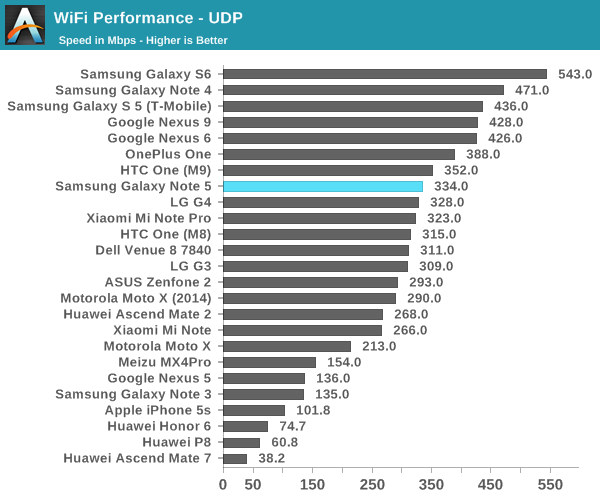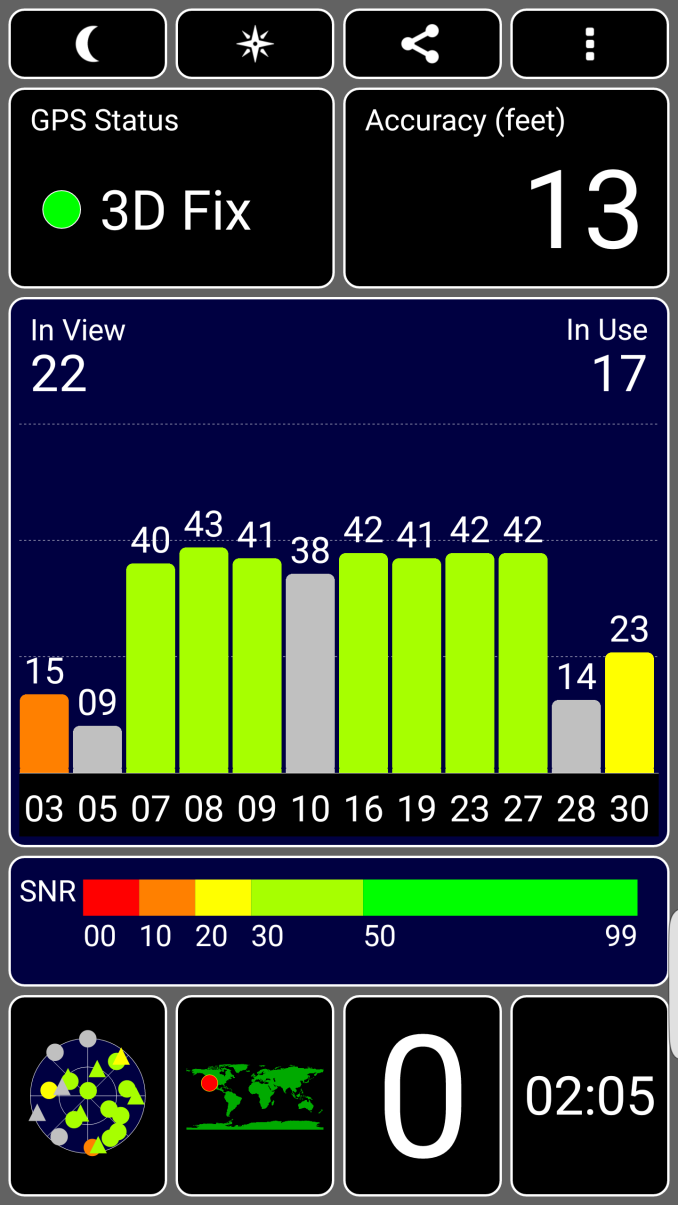The Samsung Galaxy Note5 and Galaxy S6 edge+ Review
by Joshua Ho on October 2, 2015 8:00 AM ESTVideo Performance
Now that we’ve taken a look at still image performance, we can look at video performance. For the most part these results should be similar to still image performance, but we’re looking at encoder efficiency, good sound recording, and effective stabilization. The Galaxy Note5 and Galaxy S6 edge+ both have OIS in order to improve stability in video recording, and for the most part the feature set of both is similar to the Galaxy S6 when it comes to video.
Galaxy Note5
Galaxy S6
Galaxy Note5
iPhone 6
For 1080p30, Samsung has elected to use 17Mbps High Profile H.264, along with a 256 Kbps stereo audio channel encoded with AAC. If this sounds familiar, it's because this is shared with the Galaxy S6. Quality is indistinguishable. Unfortunately, it seems the same sort of jerky OIS reset effect is still present although it isn't too obvious in these videos.
Galaxy S6
iPhone 6
It probably goes without saying, but once again the Galaxy Note5 shares the same video encode settings with the Galaxy S6, with 28 Mbps High Profile H.264 encoding for 1080p60 video. In these samples you can more clearly see the issues that come with OIS in video, which is that there are instances of jerky video movement when it should be relatively smooth, even if it's shaky. The only real difference between the Galaxy S6 and Note5/S6 edge+ is that the Note5 removes a bit of the yellow tinge/saturation boost that we see in the Galaxy S6. There's otherwise relatively little to comment on here.
Once again, not much is different when comparing the Galaxy Note5 and Galaxy S6 edge+ to the Galaxy S6 other than saturation differences in some cases. The same encoder settings are also used for 48 Mbps HP H.264 with 256 Kbps AAC stereo audio.
Galaxy Note5
Galaxy S6
Galaxy Note5
iPhone 6
If you're able to read the trend, you can probably guess that the Galaxy Note5 and S6 edge+ are going to share the same encode profiles as the Galaxy S6, which is 48Mbps HP H.264. Once again, quality is effectively identical here and the changes are slim to none. This unfortunately means that the iPhone 6 still leads here as the quality of the slow motion video on the Galaxy Note5 and Galaxy S6 line weren't much good to begin with.
WiFi Performance
For the most part, it probably goes without saying that one of the cornerstones of a smartphone or phablet is mobile data. After all, without mobile data you’re effectively limited by whatever WiFi hotspot you can find, which is often limited in range. Comparatively speaking, mobile data is generally more versatile. However, in the case of most mobile devices WiFi is often used at home in order to utilize a normally lower-latency connection with generally higher throughput. Given the reality of data caps, WiFi is also often needed for things like app updates, video streaming, and possibly music streaming. As a result, poor WiFi can sink a phone. In order to try and get a basic measure of performance, we look at peak UDP bandwidth using iPerf. In the case of the Galaxy Note 5, Samsung has upgraded the WiFi chipset from the BCM4358 used in the Galaxy S6 to Broadcom’s BCM4359. This is supposed to allow connections to 2.4 and 5 GHz WiFi simultaneously, but in practice it doesn’t really look like it’s used outside of potentially faster scanning.

Interestingly, I was unable to get the download speeds that I was expecting from a 2x2 802.11ac WiFi solution despite using 5 GHz. It's possible that this is due to interference as I can't isolate the system from other WiFi hotspots in the area, but in my experience I never had any real issues with WiFi that I could notice. Reception doesn't seem to be any better or worse than other devices I've tried in recent memory.
GNSS Performance
GNSS is often critical to a mobile device these days, as a number of applications rely on highly accurate location in order to work properly. Probably the most obvious case here is going to be GPS navigation, but things like lost/stolen device location, geofencing, location-based check-ins, and other applications are all generally quite reliant on accurate location that only GNSS systems can provide. In the case of the Galaxy Note5 and Galaxy S6 edge+, we see that the GNSS module is shared with the Galaxy S6 for the Shannon modem variants as a BCM4773 GNSS location hub is present within the system.
In practice, I didn’t find much wrong with this solution. Time to first lock without any assistance data took about 30 seconds, and at the 46 second mark the maximum possible accuracy was achieved. With assistance data, a position fix was reported within 5 seconds of launching the GPS Test app. Overall, I doubt anyone will face any real problems dealing with GPS/GNSS location on these devices.











225 Comments
View All Comments
The0ne - Friday, October 2, 2015 - link
WTF, so you want him to voice on something that doesn't exist then? That's just stupid. I bet you use this argument all the time to feel good about yourself. lol. Be easier if you just tell him to not bother in your little fight at all. Makes much more sense.Sttm - Friday, October 2, 2015 - link
Go cry about your real world problems and leave the comments sections of a tech site to us! I'm sure there is a starving kid somewhere that can use your tiny violin services.The0ne - Friday, October 2, 2015 - link
He's not crying, he's laughing at you and the other people bitching about the two companies RATHER than enjoying the devices. You totally misunderstood and misinterpreted his comment. Tech sites needs smart people, please just leave. Take your fanboy arguments elsewhere.And thanks for sharing something a little about your selfish self, all from your stupidity.
melgross - Saturday, October 3, 2015 - link
Oh, shut up!kspirit - Saturday, October 3, 2015 - link
No. >:(generalako - Saturday, October 3, 2015 - link
A more recognized source is the industry standard DisplayMate. Take a look at their tests of the newest Samsung flagships. Ever since the S5, they have been leading in the mark, and ever since the Note 4, their displays have been "considerably better" than the best LCD display (iPhone 6) out there, on virtually every category (contrasts, black levels, efficiency, color accuracy, brigthness, performance in bright lights, viewing angles, sharpness, etc.)http://www.displaymate.com/Galaxy_Note5_ShootOut_1...
Anandtech's test is hard to take seriously when they can't even rate the true peak brigthness of the Samsung phones. They don't even mention that they have left it out of their test! When put on auto brigthness, the Note 4, S6 and Note 5 all get far higher brightness than on manual. The Note 5 can reach 861 cd/m2. That's 50% more than Anandtech claim.
Take a look at DisplayMate's review. They give a proper analysis of the display, which contradicts the Anandtech review on so many areas it's funny.
Peichen - Monday, October 5, 2015 - link
DisplayMate is a Samsung marketing partner. I wouldn't trust it consider them never mention the lackluster AMOLED sub pixel arrangement.MattL - Saturday, October 10, 2015 - link
What the hell are you talking about... first of all read the DisplayMate Samsung review again and search for "Diamond" where they outline the Diamond sub-pixel arrangement. They also have a completely separate article detailing this arrangement (including a zoomed in picture):http://www.displaymate.com/Diamond_29.html
Also in the review in their spec lists they list the sub-pixel count so you can fully compare resolution and sub-pixel counts... hell for their distance in which 20/20 vision can be resolved by the human eye they include stats for the different subpixel counts (which are different per color based on the Diamond arrangement).
How you missed all that I have no clue other than you didn't bother to actually read it.
Also on your first point, Displaymate has been a leader in screen calibration for a long time now... this is their specialty and not the speciality of Anandtech, hence why people take them far more seriously on that topic... it's also why it's a bit surprising Anandtech keeps coming up with different (and less detailed) results, especially when Anandtech doesn't include important values and analysis)... You should really know what you're talking about before you make such a bold response.
Also Displaymate rates the iPhone screens *very* well, just not as a good as Samsung for the past couple generations. You do realize of course that Apple sources their screen manufacturing from a variety of companies... including Samsung, so it makes complete sense that Samsung is doing better when they finally decided to put the resources into it.
Kamus - Sunday, October 4, 2015 - link
On par? You do realize that a Delta below 3 is very much unnoticeable when it comes to gamut and grayscale calibration right?This means that even the galaxy note 4 display smokes any iPhone display to date, because EVERY LCD that has ever been made has downright comical contrast ratio. And OLED on the other hand has the end game in contrast, as in, its perfect.
The only reason this isn't more obvious is because most of the content viewed in smartphones is bright and viewed in very bright environments. Which sort of gives LCDs a free pass since its contrast ratio deficit isn't as obvious as in those situations.
You should know that videophilies spend thousands of dollars on displays that offer even slightly better contrast ratios. And here we have a situation where we go from terrible contrast, to perfect. Watch any sort of dark content on both displays at the same time in a light controled environment and you'll immediately see how these Samsung displays are simply in a whole different league.
Then there's is also the fact that the color gamut is also much wider on OLED, so if the day ever came that we finally decide to stop using the obsolete sRGB standard, OLED would also have an advantage there. (Somethg that had been ironically seen as a disadvantage before they started shiphing phones with color profiles, because the gamut is so wide it results in over saturated colors if a profile isn't is used for sRGB)
I also have to question the brightness results that anandtech got from their unit. Displaymate stated that this is the brightest smartphone display they have ever tested, they get over 800 Nits on their unit. Making it by far the best display you can use under the sun.
To meet it seems obvious that LCD has been surprised in most meaningful metrics, and its only going to get worse for LCD as OLED continues to evolve. LCD has never been good enough, but as it matured it got to a point where it became really good in a lot of ways compared to CRTs (never in contrast or switching times)
TL;DR: these Samsung displays are the benchmark every other display has to be compared to.
thedons1983 - Sunday, October 18, 2015 - link
Yeah, but it's made by Apple, and is pretty much exclusively sold, therefore, to sheep, whom generally have no idea what they are talking about. I'd rather not have a smartphone at all, than one of those ugly ass iphones. But then, that's probably because I actually have taste, and don't just buy whatever hipster rubbish is currently en vogue.